
Performing trend and product analytics can help you make data-backed informed decisions to stay ahead of the competition.
With trend analysis, you’ll be able to better understand both internal and external factors affecting your business operations.
But what exactly is a product trend analysis, how do you conduct it, and how does it help predict future trends to improve customer satisfaction? All great questions, and we’ve got the answers right here, so let’s dive in!
Try Userpilot Now
See Why 1,000+ Teams Choose Userpilot

Summary of product trend analysis
- Product trend analysis involves examining historical and current data to uncover any shifts or patterns of user behavior within your product. These insights can then be used to predict future trends, plan for seasonal fluctuations, and improve the customer experience.
- Apart from the above reasons, product trend analysis offers several more advantages. For example, it helps uncover customer pain points, which you can learn from to improve onboarding and plan product development.
- While there are several trend analysis types, here are the three basic ones everyone should know:
- Geographic trend analysis: Analyze and compare data points across various regions and locations.
- Temporal trend analysis: Track changes in trends during a specific period or compare trends across periods.
- Intuitive trend analysis: Rely on your years of experience and intuition to come up with logical explanations for shifts in customer behavior.
- Here are the five steps you need to follow when performing product trend analysis:
- Goal-setting: What is your objective for this analysis?
- Data collection: Gather relevant data, such as usage or engagement data, from your product.
- Data visualization: Trends and patterns are easier to discern when viewed, with the help of the right visualization tool.
- Analysis and data filtering: Finally, look at the data from various angles to understand what it says.
- Always iterate: Based on your findings from the trend analysis, make the appropriate changes and updates where needed.
- Here are some examples of when analyzing trends could be useful:
- Feature engagement trend to see if users are actively and regularly using a specific feature.
- Feature usage comparison to measure usage differences between features and understand why one is performing better or worse.
- Common features and events to see what functionality is most in demand with your target audience.
- Product usage by device to ensure that your product is appropriately optimized for the device it’s most used on.
- Impact of feature updates to examine whether your efforts are even making a difference to user satisfaction or not.
- Ready to start conducting product trend analysis for your SaaS? Book a demo now to see how Userpilot can help you better understand customer behavior.
What is product trend analysis?
Product trend analysis is a research methodology used to examine current and historical data to identify patterns, shifts, or developments over time in customer behavior related to your product.
Trend analysis focuses on gaining valuable insights into when and why customers perform certain actions. And then use these findings to predict future events and trends, and make better-informed product decisions.
For example, after analyzing historical data, you find that feature usage of your billing feature increases at month-end. Armed with this knowledge of seasonal trends of usage, you can plan new launches or updates accordingly around month-end for maximum feature adoption.
Why should you conduct product trend analysis?
By now, we’ve discussed how historical trend analysis can help you understand consumer behavior. But analyzing product trends is also crucial and beneficial for myriads of other reasons, some of which are listed below.
- Improve user onboarding: Trend analysis of user onboarding may uncover a drop in engagement, highlighting a faulty onboarding process and an opportunity to improve the user experience.
- Product development: Use trend analysis to understand how users interact with your product and what features resonate with them to aid future feature development.
- Uncover scalability challenges: Studying product usage patterns and trends can uncover potential scalability challenges and customer pain points before they become an issue.
What are the three basic types of trend analysis?
There are several types of trend analysis you could use to study internal customer patterns or the overall market trend. However, three basic analysis types are the most popular and frequently used. Let’s look at what these are.
Geographic trend analysis
This type of data analysis is used to compare data across different geographical locations and regions.
If you are an international SaaS company with users scattered across the globe, then performing geographic trend analysis can be very useful. Identifying a market trend in one region can potentially help predict how the trend might develop in other regions.
Moreover, such analysis also helps you customize your product offering for each region you operate in.
Temporal trend analysis
Temporal analysis focuses on studying any shift in trends during a specific period. You could also compare the temporal analysis of one period to another to gain further insights into changing patterns over time.
Let’s look at an example. Your invoice generator feature had a bug, which caused some negative customer feedback. Once you remove the bug with a feature update, how do you check if users are happy now?
One good approach would be to use temporal trend analysis to track changes in your NPS score before and after the feature update.
Intuitive trend analysis
This method is used to explain and analyze trends within user segments based on – you guessed it – intuition. Relying on intuition doesn’t mean guessing on a whim, though!
Instead, intuition means coming up with logical explanations based on a mix of your industry expertise, external factors like market trends, and other qualitative insights.
For example, the numbers might say one thing when interpreting customer feedback and sentiment. But don’t forget to use your intuition and the human element to make sense of the feedback more logically.
How to perform product trend analysis?
Product trend analysis might sound like a technical analysis that only data-savvy people can perfect. But in reality, that isn’t the case at all. You don’t have to be a data scientist or coder to perform this analysis on your own.
The only thing you need to know are the five steps of performing product trend analysis, which we discuss below.
Determine your analysis goals
Always start by asking yourself why you want to perform trend analysis and what you hope to achieve with it.
The goal doesn’t have to be super elaborate and complicated. It can be as simple as looking to improve user engagement, identify popular features, or collect insights for product development.
If you’re still confused, try using a goal-setting framework to get started, like the S.M.A.R.T one below.
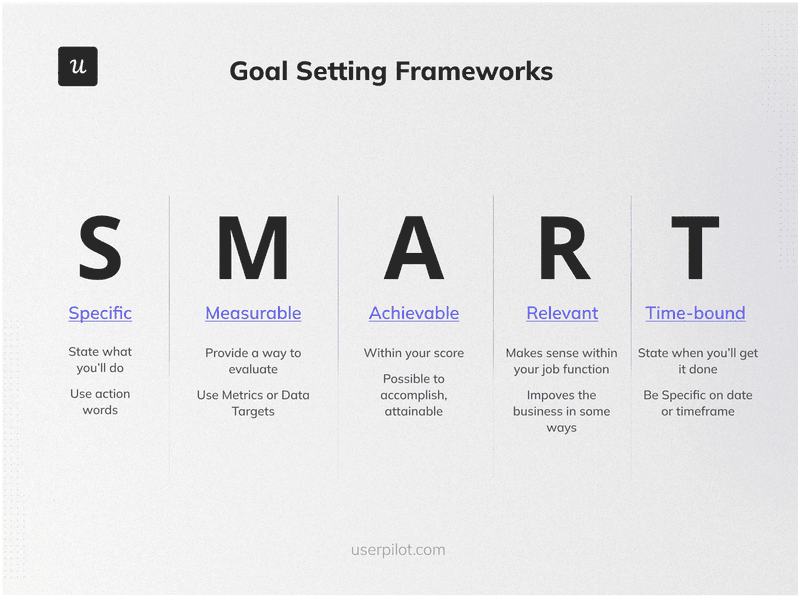
Collect relevant data for your product trend analysis
Before you can start performing any trend analysis, you need to collect data for it. Of course, not just any sort of data – data that is relevant to your goal.
For example, if your goal is to improve user engagement, you should tag features to collect feature engagement and event data. Alternatively, you could also use in-app surveys to collect feature engagement feedback.
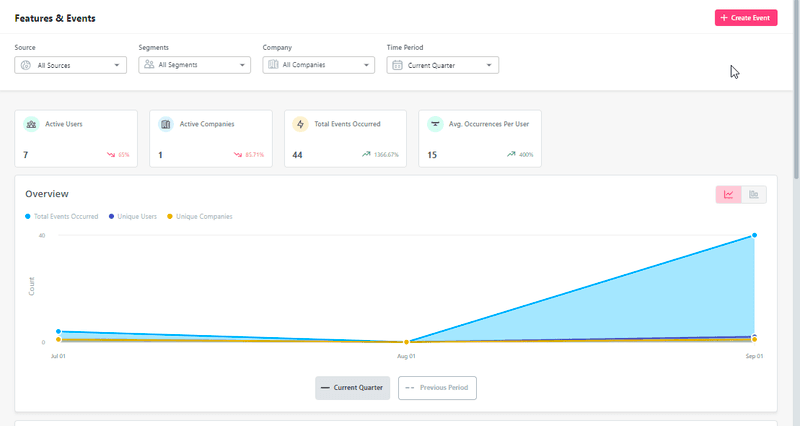
Use a data analytics tool to visualize trend data
Manually trying to sift through, compare, and analyze data on your own is too much work for even the best product team out there.
Instead, make life easier by choosing the right data analytics tool that visualizes data for you, making it easier to identify trends at a glance.
A good example is Userpilot, which lets you use trends to analyze top events, determine the count of unique users firing events, and identify users’ occurrences in your product. Plus, it also has various trend reports and chart types to let you plot aggregated response data to make your visual analysis even easier.
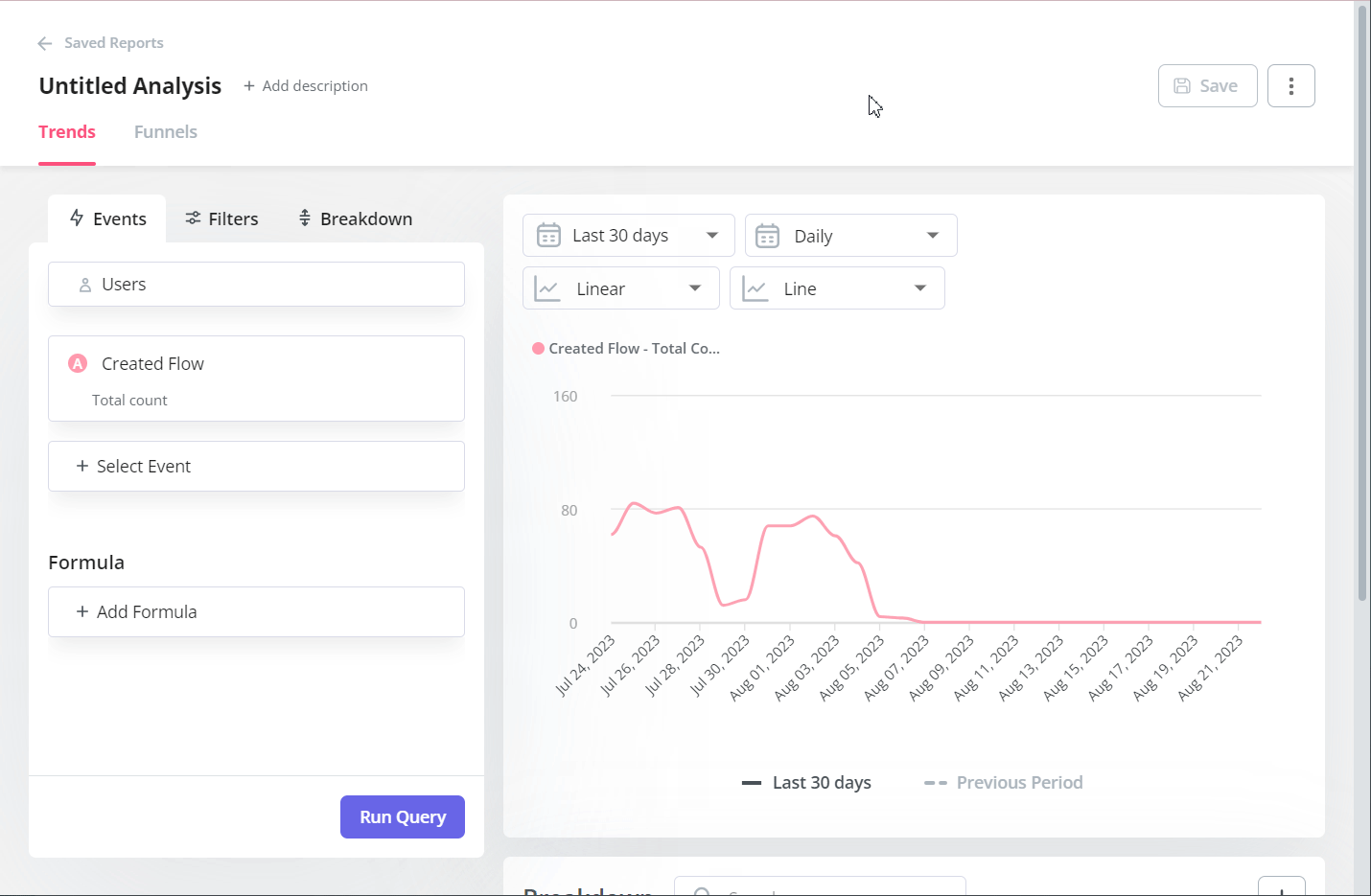
Filter and analyze your data to identify trends
To further understand why these current trends and patterns exist, you have to play around with your trend data. This means applying specific and relevant filters to examine data from different angles.
For instance, you can break down data based on the product plan. This enables you to understand how users on different plans engage with your product’s core features. Having this information can help you make business decisions better suited for the relevant target audience.
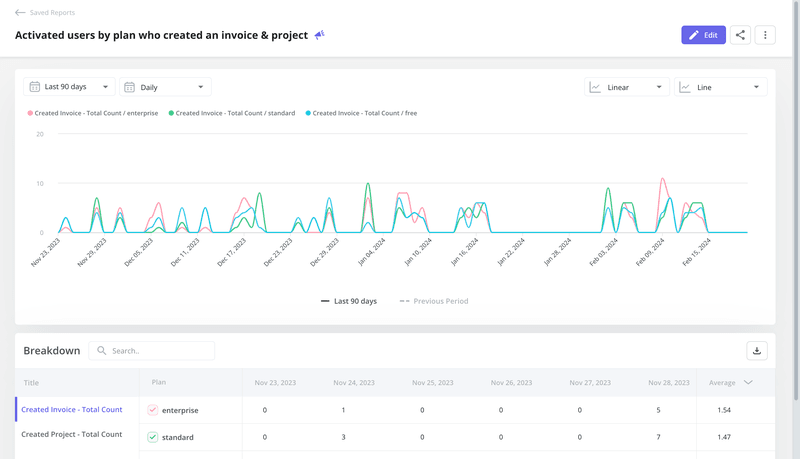
Make iterations based on your findings
Lastly, conducting a product trend analysis isn’t a one-and-done process. It involves constantly improving in response to what the trend data suggests.
These improvements could take on many different forms, such as updating features, refining user experiences, or adapting marketing campaigns. Whatever the required improvement may be, don’t shy away from making iterations, otherwise, your whole analysis will go to waste!
What are examples of product trend analysis in SaaS?
Whenever you’re learning a new skill, looking at examples always helps. This is why we’ve compiled a list of examples for you to understand when it makes sense to perform product trend analysis and what insight you can draw from it. Let’s look at what these examples are!
Feature engagement trend
Feature engagement is a key metric that shows how effectively and actively users are interacting with your features.
Engagement can drop for several reasons, which is why performing feature engagement trend analysis is useful. This data analysis involves tracking the engagement level of a specific feature over time across your user base. It helps narrow down when engagement patterns change so that you can work on understanding why.
To track feature engagement trends, simply analyze the count of DAUs, WAUs, and MAUs you have over specific periods.
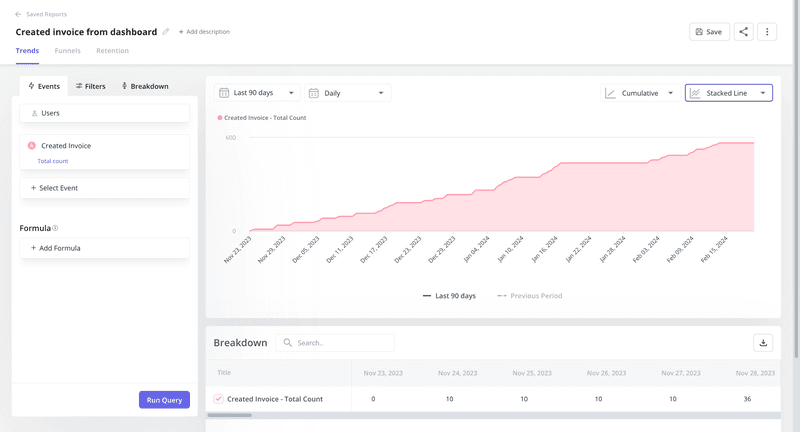
Feature usage comparison
Another engagement metric commonly used to track how many users have adopted a feature is the feature usage rate.
To gain deeper insights into feature usage fluctuations, you can try contrasting the trends between two features. This type of analysis is called feature usage comparison, and, as the name suggests, it lets you compare engagement levels between two features.
This is helpful because you might be able to learn why one feature is performing better than the other. Once you have that information, you can then try introducing similar functionality into the lower-performing feature as well, to boost its usage.
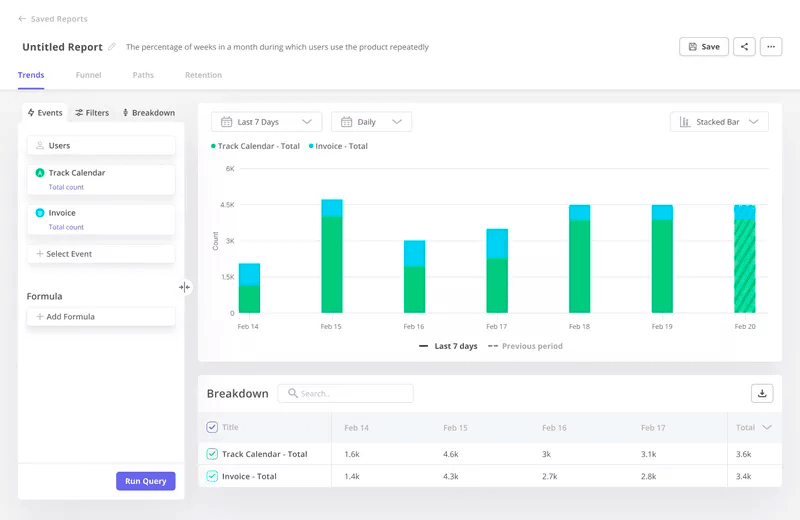
Common features & events
Data analysis doesn’t always have to involve a deep dive into a specific feature or two. Sometimes, it is beneficial to simply track what the most used features or events are across your product. For starters, it can help predict a change in consumer behavior, so you can adapt accordingly.
For example, let’s say your top-used feature was generating analytics reports. However, you notice the feature’s popularity showing a downward trend. At the same time, the data visualization features, like graphs, seem to have an upward trend.
These trend changes are an early warning indicator that users want more visualization tools, so that’s what you should focus on developing.
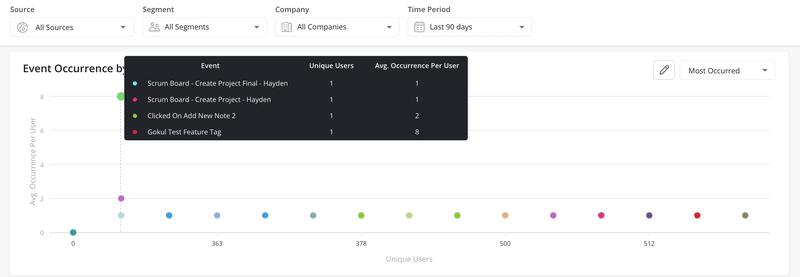
Product usage by device
In order to cater to your target audience better, you need to know more about them.
And one way to learn more about your users is by performing trend analysis on their product usage by device. This enables you to easily compare and see what devices users operate your product on the most. Once you know, you can then implement user experience optimizations accordingly.
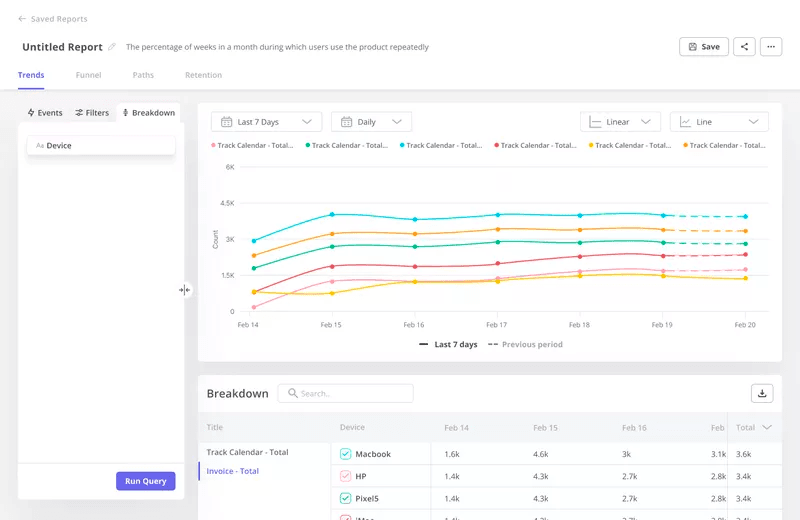
Impact of feature updates
Lastly, a great product trend analysis example is to study the impact of feature updates. This is useful because it helps see if the feature update actually helped users or not.
To measure the impact, track the feature engagement levels before and after the feature update. You can then combine this with additional insights from a post-update satisfaction survey to come up with plausible methods on how to improve your product.
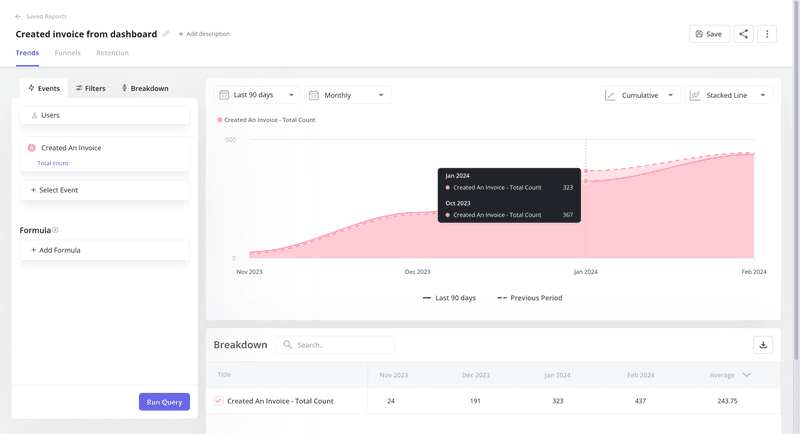
Conclusion
For any SaaS business looking to adapt to evolving market dynamics and customer needs, product trend analysis is an invaluable tool.
You can use trend analysis to optimize features and refine product development strategies. All this will inevitably lead to increased user satisfaction and a sustainable competitive advantage for your business!
Want to get started performing product trend analysis? Get a Userpilot Demo and see how you can better understand what your users want and improve satisfaction.







